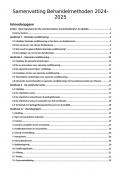Samenvatting
Behandelmethoden - Complete en Uitgebreide Samenvatting (2024)
- Instelling
- Tilburg University (UVT)
Complete en uitgebreide samenvatting van Behandelmethoden (500806-M-6). Dit is zowel de verplichte literatuur als de extra literatuur gegeven tijdens de gastcolleges. Dit is een samenvatting die je helemaal voorbereid voor het tentamen. Het vak is onderdeel van de Master Klinische Psychologie en wo...
[Meer zien]













